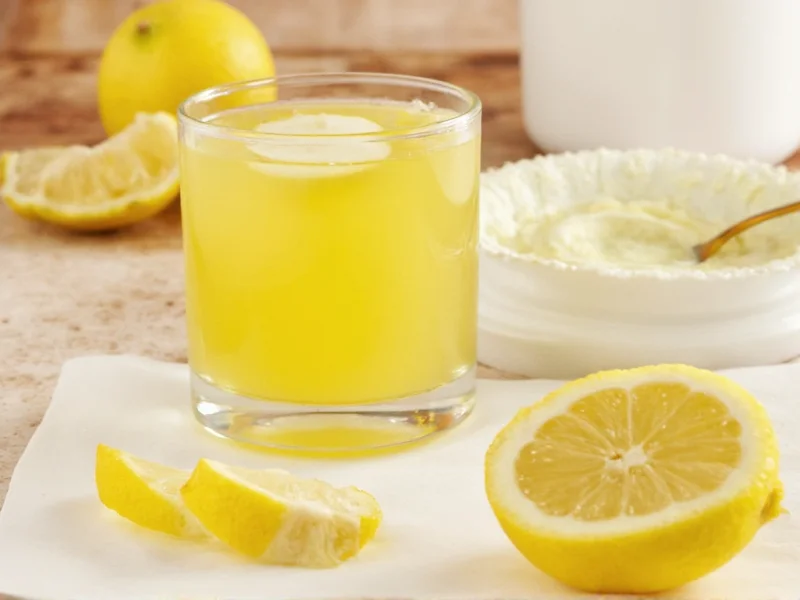Understanding Lemon Juice as a Citric Acid Substitute
When you're in the middle of a recipe and realize you've run out of citric acid, lemon juice becomes your most accessible substitute. Both ingredients provide acidity, but they're not chemically identical. Citric acid is a pure crystalline compound (C6H8O7), while lemon juice contains citric acid along with other compounds, water, and natural sugars.
The key to successful substitution lies in understanding their concentration differences. Commercially prepared citric acid is 100% acid, whereas fresh lemon juice typically contains 4-6% citric acid by weight. This concentration variance directly impacts your substitution calculations and final recipe results.
Chemical Composition Comparison
| Property | Citric Acid | Lemon Juice |
|---|---|---|
| Acid Concentration | 100% pure acid | 4-6% citric acid |
| pH Level | 2.2 (when dissolved) | 2.0-2.6 |
| Water Content | 0% | Approximately 90% |
| Additional Components | None | Vitamin C, flavonoids, sugars |
When Lemon Juice Works Best as a Substitute
Lemon juice substitution performs optimally in applications where flavor compatibility matters less than acidity. For home canning and preserving, the USDA recommends using bottled lemon juice rather than fresh for consistent acidity levels. When substituting in cheese making, particularly for paneer or ricotta, lemon juice provides similar coagulation properties to citric acid with the added benefit of subtle citrus flavor.
In beverage preparation like homemade sodas or sour cocktails, lemon juice often improves the final product by contributing both acidity and complementary flavor. The natural sugars in lemon juice can balance tartness better than pure citric acid in these applications.
Limitations of Lemon Juice Substitution
Certain applications require precise acidity levels where lemon juice substitution becomes problematic. In winemaking, citric acid measurements must be exact to prevent bacterial growth and ensure proper fermentation. The variable acidity in lemon juice makes it unsuitable for this purpose.
For commercial food production, regulatory requirements often specify citric acid by weight rather than volume, making lemon juice substitution impractical. Additionally, in clear beverages like certain sodas or medicinal syrups, lemon juice would introduce cloudiness and unwanted flavor notes that pure citric acid avoids.
Precision Substitution Guide
Accurate substitution requires understanding both volume and acidity adjustments. The standard conversion ratio serves as a starting point, but recipe-specific adjustments may be necessary:
| Citric Acid Required | Lemon Juice Substitute | Additional Adjustment |
|---|---|---|
| 1 teaspoon (5g) | 1/2 cup (120ml) | Reduce other liquids by 1/4 cup |
| 1 tablespoon (15g) | 1 1/2 cups (360ml) | Reduce other liquids by 3/4 cup |
| 1/4 cup (60g) | 6 cups (1.4L) | Reduce other liquids proportionally |
When substituting in baking recipes, remember that lemon juice's additional liquid content affects dough consistency. For every 1/2 cup of lemon juice used, reduce other liquids by 1/4 cup to maintain proper hydration levels. In canning applications, always use bottled lemon juice to ensure consistent pH levels of 2.0-2.6 for safe preservation.
Step-by-Step Substitution Process
Follow these steps for successful substitution in most culinary applications:
- Determine the required amount of citric acid in your recipe
- Calculate the equivalent lemon juice using the 1/2 cup per teaspoon ratio
- Adjust total liquid content by reducing other liquids proportionally
- Consider flavor compatibility - will citrus notes enhance or interfere?
- Taste and adjust acidity if possible before finalizing your recipe
For preserving high-acid foods like fruits, maintain a pH below 4.6 for safety. When substituting in these applications, verify final pH with testing strips, especially when preserving tomatoes or figs which naturally have higher pH levels.
Alternative Substitutes When Lemon Juice Isn't Suitable
While lemon juice serves as the most accessible citric acid substitute, other options work better in specific situations. Lime juice provides similar acidity with a different flavor profile, substituting at the same 1/2 cup per teaspoon ratio. For applications requiring pure acidity without citrus flavor, tartaric acid (cream of tartar) works at a 1.5:1 ratio (1.5 teaspoons cream of tartar per teaspoon citric acid).
In commercial settings or when precise pH control is critical, consider ascorbic acid (vitamin C) as an alternative, though it provides less acidity per volume. For every teaspoon of citric acid, use 1.5 teaspoons of ascorbic acid, recognizing it won't provide identical functional properties.
Practical Application Examples
For homemade bath bombs: When citric acid reacts with baking soda, it creates the characteristic fizz. Substitute with lemon juice at a 1:3 ratio by weight (1 part lemon juice to 3 parts baking soda), but expect reduced fizzing action and potential discoloration from the juice.
In cheese making: For 8 ounces of milk, use 2 tablespoons of lemon juice instead of 1/4 teaspoon citric acid. The natural pectin in lemon juice aids coagulation, often producing creamier results than pure citric acid.
For canning tomatoes: The USDA recommends 2 tablespoons of bottled lemon juice per quart instead of 1/2 teaspoon citric acid. This ensures proper acidity while adding complementary flavor to the preserved tomatoes.











 浙公网安备
33010002000092号
浙公网安备
33010002000092号 浙B2-20120091-4
浙B2-20120091-4